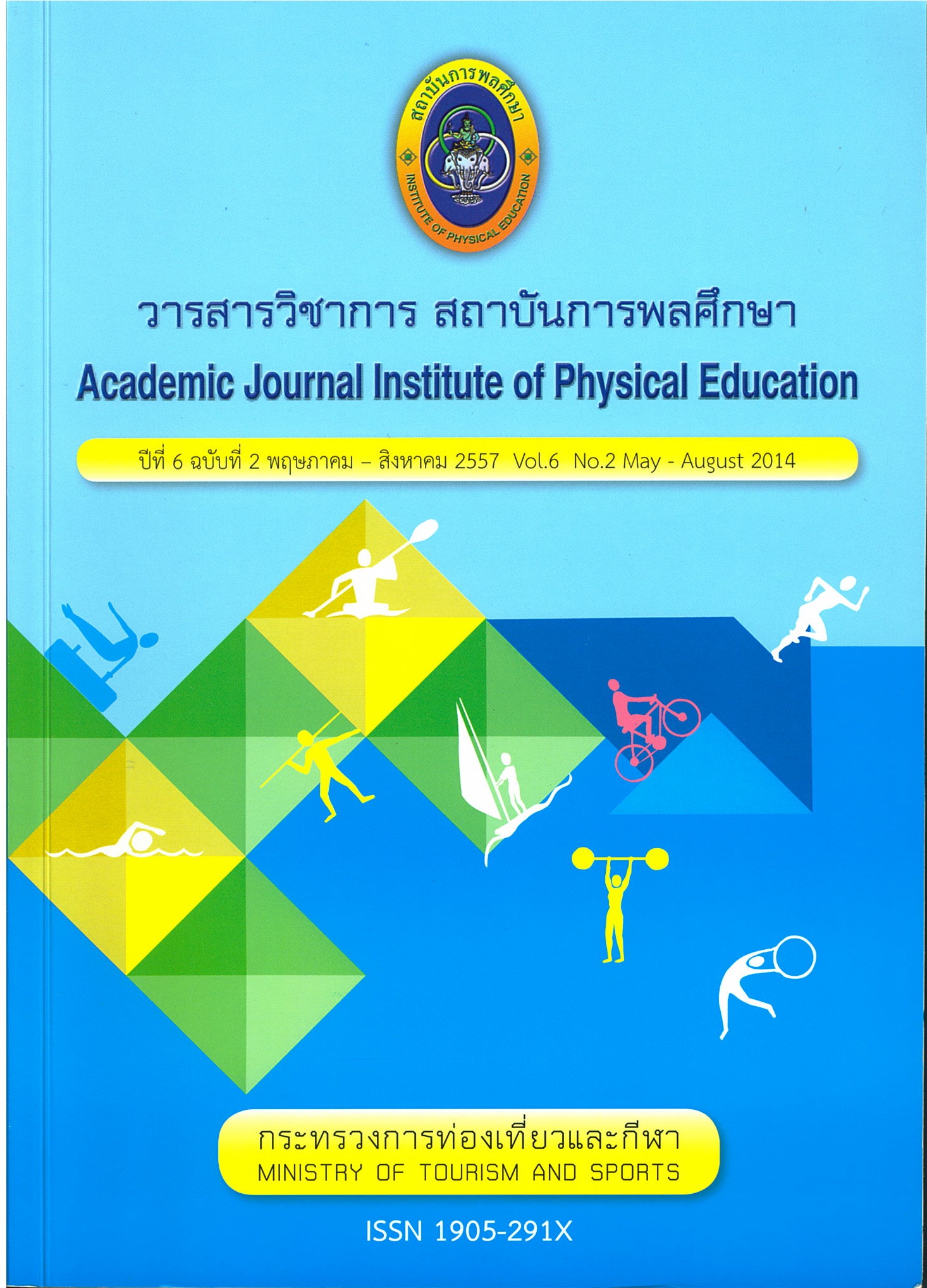Innovative Sport and Physical Activity Management for Motor Ability and Social Interaction Development in Children with Autism
Main Article Content
Abstract
The Ministry of Education policy assigned to the Office of The Basic Education Commission on 2,700 Inclusive Schools pilot project to merge children with autism to study with normal children in the year 2007. Without preparing on social interaction in children with autism which a fundamental problem before attended by teachers or parents.
The purposes of this mixed research were: 1) to create innovative sport and physical activity to develop motor ability for children with autism. 2) to study the effects of management innovation in motor ability and social interaction of children with autism and compare innovation with sample individually. 3) to study how to manage innovation, sport and physical activity development of motor ability and social interaction of children with autism. The significance of this research is the motor ability to develop the brain activities and coordination of hand and eye that affects social interaction, which is an important part of social awareness for children with autism. Innovative sports and physical activity can help develop children with autism Parents and Inclusive School teachers may and set up innovative social enterprises in the future to tutor special students with differentiating talents. The sample group was 5 autistic students in the second semester, academic year 2013, Ban Nong-bau Inclusive school pilot project, Udon Thani. The purposive sampling method was applied for the sample group.
Methodology: the instruments used in the study were 1) five innovative sports and physical activities for motor ability and social interaction. 2) the motor ability and social interaction achievement test, Time-Series Research Design, percentage, mean, and econometrics were the parameters used for statistical analysis. 3) depth interviews, SWOT Analysis, SFAS and experts roundtable participations were used for management process.
The findings of the research revealed that: 1) a quantitative, five innovations of sport and physical activity developed motor ability and social interaction to higher feathers statistically significant at the .01 level. 2) a qualitative, management plan where administrators, teachers, parents and researchers succeeded and worked in a
collaborative way. The roundtable participants of experts have commented in the same direction every step of the planning and research.
Conclusion: Innovations of this research can be a social enterprise for Inclusive School activities and combined with parents. They can improve motor ability in children with autism without waiting for the results to predict autism symptoms by medical process.
Article Details

This work is licensed under a Creative Commons Attribution-NonCommercial-NoDerivatives 4.0 International License.
The published article is a copyright of the Academic Journal of Thailand National Sports University. The passage appeared in each article in this academic journal is a perspective of each author which is not related to the journal. Each author is required to be responsible for all components of his/her own article. If there are any mistakes, each author must be responsible for those mistakes on his/her own.
References
มูลนิธิออทิสติกไทย. (2556.) แถลงการณืรณรงค์ออทิสติกไทย 2013. (ออนไลน์). เข้าถึงได้จาก http://www.awareness.autisticthai.com/index.php?name=news&file=readnews&id=13 (1 พฤษภาคม 2556)
ศูนย์วิจัยและพัฒนาการจัดการศึกษาพิเศษแบบเรียนร่วมสําหรับเด็กออทิสติก. การวินิจฉัยโรคออทิสซึม. เข้าถึงได้จาก http//:ednet.kku.ac.th/~autistic/pages/knowlage_treatment.html, (20 waualnu 2555).
American Psychiatric Association. (1994). Diagnostic and Statistical Manual of Mental Disorders: DSM-IV (Internet]. (4th ed). Washington (DC): American Psychiatric Association. Available from: http://www.psychiatryonline.com/DSMPDF/dsm-iv.pd. (April 20, 2012)
Bryson, S. E. and Smith I. M. (1998). Epidemiology of Autism: Prevalence, Associated Characteristics, and Implications for Research and Service Delivery. Mental Retardation and Developmental Disabilities Research Reviews, 4, 97-103.
Corbin, C.B. (1977). Physical education: A view toward the future. A new wisdom for physical education. In R. Welsh (Ed.), @p. 160-164). St. Louis: C.V. Mosby.
Huebner, R.A. & Kraemer, G. (2001). “Sensorimotor aspects of attachment ans social relatedness in autism." In R. A. Huebner(ed). Autism: A sensorimotor approach to management (pp. 209-244) Gaithersburg, MD: Aspen.
Järbrink, K, Althoff, K. and Rubinstein, B. (2012). Socio-economic Impact on health care utilisation in a segragated city. Socialmedicinsk Tidskrift, 89 (3), 280-288.
Mary M. Smyth*, Heather I. Anderson. (2000). Coping with clumsiness in the school playground: Social and physical play in children with coordination impairments. British Journal of Developmental Psychology . Volume 18, Issue 3, pages 389-413, September
Morrison, Gillian. (2002). Moving to Learn in Country Schools. Brain Gym®Journal. Nov. Volume XVI. No. 3.
World Health Organization (WHO). (1992). The ICD-10 Classification of Mental and Behavioral Disorder: Clinical Description and Diagnostic Guidelines. Geneva: World Health Organization.


